The Americans are not a gay people, but they are fond of a joke. Lincoln’s “little stories” were characteristically Western, and it is doubtful whether he was more endeared to the masses by his solid virtues than by the humorous perception which made him one of them. The humor of which we are speaking now is a strictly popular and national possession. Though America has never, or not until lately, had a comic paper ranking with Punch or Charivari or the Fliegende Blaetter, every newspaper has had its funny column. Our humorists have been graduated from the journalist’s desk and sometimes from the printing-press, and now and then a local or country newspaper has risen into sudden prosperity from the possession of a new humorist, as in the case of G. D. Prentice’s Courier Journal, or more recently of the Cleveland Plaindealer, the Danbury News, the Burlington Hawkeye, the Arkansaw Traveller, the Texas Siftings, and numerous others. Nowadays there are even syndicates of humorists, who co-operate to supply fun for certain groups of periodicals. Of course, the great majority of these manufacturers of jests for newspapers and comic almanacs are doomed to swift oblivion. But it is not so certain that the best of the class, like Clemens and Browne, will not long continue to be read as illustrative of one side of the American mind, or that their best things will not survive as long as the mots of Sydney Smith, which are still as current as ever. One of the earliest of them was Seba Smith, who, under the name of “Major Jack Downing,” did his best to make Jackson’s administration ridiculous. B. P. Shillaber’s “Mrs. Partington”—a sort of American Mrs. Malaprop—enjoyed great vogue before the war. Of a somewhat higher kind were the Phoenixiana, 1855, and Squibob Papers, 1856, of Lieutenant George H. Derby, “John Phoenix,” one of the pioneers of literature on the Pacific coast at the time of the California gold fever of ’49. Derby’s proposal for A New System of English Grammar, his satirical account of the topographical survey of the two miles of road between San Francisco and the Mission Dolores,




